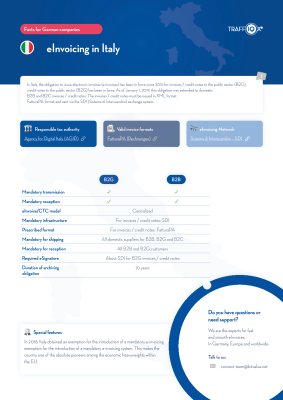eInvoice – How Electronic Invoicing Works in Italy
For several years, Italy has been a pioneer in the introduction of eInvoicing within the EU. The obligation to issue electronic invoices began in 2015 for invoices addressed to public authorities (B2G) and was extended on January 1, 2019, to include domestic B2B and B2C invoices. This step has significant implications for German medium-sized companies engaged in import and export with Italian partners.
Hard-Won: How Italy Started with Electronic Invoices
This mandatory system, known as the Sistema di Interscambio (SDI), has applied to all domestic invoices since its introduction. The obligation for electronic invoicing includes not only invoices issued to businesses (B2B) and consumers (B2C) but also to public authorities (B2G).
What to Keep in Mind About Electronic Invoicing in Italy
Accordingly, all invoices must be created in the standardized and structured XML format FatturaPA and transmitted via the aforementioned central exchange system SDI (Sistema di Interscambio). To ensure full compliance with regulations, everything is strictly monitored by the competent authority, the Agency for Digital Italy (AGID). If the controls reveal issues, such as missing mandatory XML tags or incorrect content, the SDI system generates an error report for the invoice issuer and halts the transmission process of the document.
While the transmission is mandatory for all domestic suppliers in the B2B, B2G, and B2C sectors, the mandatory receipt of electronic invoices only applies to companies and public administrations. Private individuals are not obligated to receive eInvoices.
The eInvoicing or CTC model (Continuous Transaction Controls), which requires Italian companies and public authorities to transmit and receive electronic invoices, is centralized. An electronic signature is only required for B2G invoices or credit notes transmitted via the SDI.
Another important detail is the archiving obligation: In Italy, eInvoices must be stored for a period of 10 years. Archiving abroad is also permitted under certain conditions.
Obligation for eInvoicing Also for Cross-Border Transactions
Since January 1, 2022, the new Italian Budget Law No. 178/2020 mandates that electronic invoicing in the XML format "FatturaPA" and transmission via the central SDI platform are also obligatory for cross-border invoices (invoices to and from companies based abroad).
For incoming invoices that Italian companies receive from suppliers outside of Italy, the Italian invoice recipients are required to create an XML version of these invoices and also transmit them to the SDI system. The transmission must take place by the 15th day of the month following the receipt of the incoming invoice. The purpose of this regulation is to provide the Italian government with the transaction information of foreign invoices in electronic form, thereby reducing tax evasion in cross-border transactions.
All Key Facts About Electronic Invoicing in Italy at a Glance:
- Transmission Mandatory for B2G, B2B, and B2C
- Receipt Mandatory for All Customers in B2B and B2G
- Centralized eInvoicing/CTC Model
- Mandatory Infrastructure for Invoices/Credit Notes: SDI (Sistema di Interscambio)
- Prescribed Format for Invoices/Credit Notes: FatturaPA (XML Format)
- Required eSignature via SDI for B2G Invoices/Credit Notes
- Archiving Obligation: 10 Years (Archiving Abroad Permitted Under Certain Conditions)
- Responsible Tax Authority: Agency for Digital Italy (AGID)
You Need Help with Electronic Invoices, Anywhere?
Anyone who wants to do business from Italy or with Italian companies must familiarize themselves early on with the somewhat complex regulations. You can learn everything about eInvoicing in an international context at the eInvoicing Academy by TRAFFIQX®.
Sounds Like a Lot of Work? It Is – But Not for You!
Want to Learn More? Schedule a Free Consultation with Our Expert Lars Becher, Key Account Manager and Subject Matter Expert for eInvoicing and CTC in the TRAFFIQX® Network.




